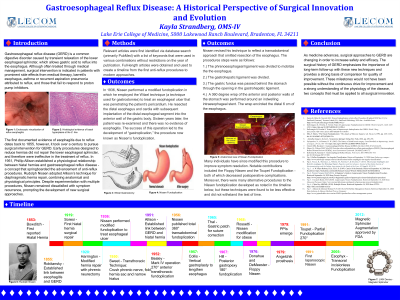General Surgery
Gastroesophageal Reflux Disease: A Historical Perspective of Surgical Innovation and Evolution

Has Audio
Introduction/Purpose: The first documented evidence of esophagitis due to reflux dates back to 1855, however, it took over a century to pursue surgical intervention for gastroesophageal reflux disease (GERD). In 1951, Phillip Allison established a physiological relationship between hiatal hernias and gastroesophageal reflux disease - a concept that springboarded the advancement of anti-reflux procedures. Rudolph Nissen adopted Allison’s technique for diaphragmatic hernia repair, combining anatomical and physiological principles. Despite experimentation with multiple procedures, Nissen remained dissatisfied with symptom recurrence, prompting the development of new surgical approaches.
Methods or Case Description: Relevant articles were first identified via database search (primarily PubMed) with a list of keywords that were used in various combinations without restrictions on the year of publication. Full-length articles were obtained and used to create a timeline from the first anti-reflux procedures to modern approaches.
Outcomes: In 1936, Nissen performed a modified fundoplication in which he employed the Witzel technique (a technique used for gastrostomies) to treat an esophageal ulcer that was penetrating the patient’s pericardium. Sixteen years later, the patient was re-examined and there was no evidence of esophagitis. The success of this operation led to the development of “gastroplication,” the procedure now known as Nissen’s fundoplication. Many individuals have since modified this procedure to improve symptom resolution. Moreover, there were many alternative procedures to the Nissen fundoplication developed, but these techniques were found to be less effective and did not withstand the test of time.
Conclusion: As medicine advances, surgical approaches to GERD are changing in order to increase safety and efficacy. The surgical history of GERD emphasizes the importance of long-term follow-up with these new techniques and provides a strong basis of comparison for quality of improvement.
Methods or Case Description: Relevant articles were first identified via database search (primarily PubMed) with a list of keywords that were used in various combinations without restrictions on the year of publication. Full-length articles were obtained and used to create a timeline from the first anti-reflux procedures to modern approaches.
Outcomes: In 1936, Nissen performed a modified fundoplication in which he employed the Witzel technique (a technique used for gastrostomies) to treat an esophageal ulcer that was penetrating the patient’s pericardium. Sixteen years later, the patient was re-examined and there was no evidence of esophagitis. The success of this operation led to the development of “gastroplication,” the procedure now known as Nissen’s fundoplication. Many individuals have since modified this procedure to improve symptom resolution. Moreover, there were many alternative procedures to the Nissen fundoplication developed, but these techniques were found to be less effective and did not withstand the test of time.
Conclusion: As medicine advances, surgical approaches to GERD are changing in order to increase safety and efficacy. The surgical history of GERD emphasizes the importance of long-term follow-up with these new techniques and provides a strong basis of comparison for quality of improvement.

Kayla Strandberg, OMS-IV
Medical Student
Lake Erie College of Medicine - Bradenton
Port Saint Lucie, FL, US
